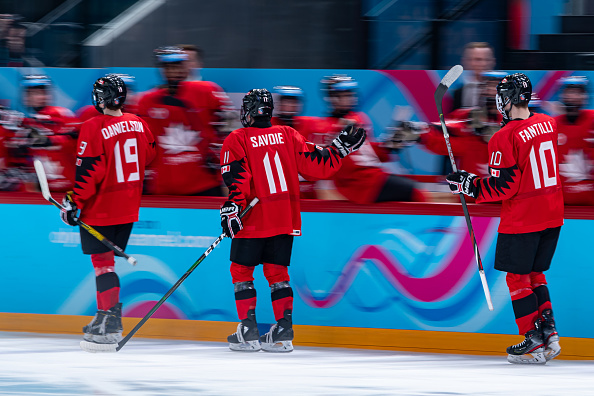Shane Wright has struggled with producing this season, recording 30 points in 22 games played. That has led to conversations regarding Wright losing the top spot in the class. The name seen most often in those arguments is Matthew Savoie, who has posted 52 points in 33 games. What does Savoie bring to the table that allows him to produce this well?
Matthew Savoie chasing Shane Wright?
Savoie, an 18-year-old centre born on January 1st, 2004 in St. Albert, Alberta, has taken advantage of his opportunities this season. With Wright not taking a step forward this season in production, Savoie has taken the chances he’s seen. The right-handed pivot stands at 5’9” and 179 pounds. Ranking third on my draft rankings, Savoie has also been ranked second by The Puck Authority, Smaht Scouting, and McKeen’s Hockey; third by Dobber Prospects and Draft Prospects Hockey; fifth by Elite Prospects, Craig Button and Sportsnet; sixth by Recruit Scouting and FC Hockey; and seventh by Bob McKenzie.
In his first WHL season with the Winnipeg Ice in the 2019-20 season, in his 15-year-old season, he recorded seven assists across 22 contests. In the following season, Savoie was forced to play outside the WHL due to covid, settling with the USHL’s Dubuque Fighting Saints. There, he recorded 21 goals and 17 assists for 38 points in 34 games played. Finally, this season, he made his return to the WHL In 33 contests, he’s scored 18 goals and 34 assists for 52 points.
Matthew Savoie Scouting Report
The production has been there. There’s no doubt that he has the skill of a top pick. But there’s so much more to the game than counting stats, especially when it comes to evaluating prospects. What does Savoie bring to the game that allows him to perform at such a high level? Can it be translated to the NHL?
Matthew Savoie is an excellent skater
To begin, let’s start with Savoie’s skating ability. He is almost always the fastest skater on the ice. He wins races consistently, and he can reach top speed quickly. The one issue, that can be coached relatively easily, is his general edge work. He can lose speed trying to complete turns, and often takes wide turns as opposed to tighter ones. Overall, however, it doesn’t do a whole lot to hold his skating back.
From a technical standpoint, Savoie is very sound. He displays full stride extension, making the most of his strides from a power/explosiveness perspective. His knee bend is generally good, but there are times where it can be inconsistent. The same can be said about his ankle flexion. But again, as mentioned, it’s not enough to hold him back, and with NHL coaching, should see big improvements.
Matthew Savoie’s Offensive abilities
Savoie has dominated offensively, as mentioned before, this season. There’s no questioning that. But what about his game offensively allows him to do so? His playmaking. Savoie loves setting up teammates, and he does so with a lot of efficiency in high-danger areas. Across three mid-December WHL games that were tracked, Savoie attempted 59 passes in the offensive zone, completing 44 of them (74.58%). His passing accuracy is worse than all of Wright, Logan Cooley and Danila Yurov (85.45%, 93.44%, and 81.33%, respectively), but there’s a caveat to that. Of his pass attempts, 25.45% of them were aimed at high-danger areas on the ice. The next closest was Wright at 23.64%, followed by Yurov (22.67%) and Cooley (9.84%).
Savoie works the perimeter really well, and has the stickhandling, vision, and IQ to set up a large amount of scoring chances for his teammates. His confidence is also clear with the way he moves around the ice and isn’t afraid to push the pace. The only problem is, he does force a lot of passes that don’t always hit. He doesn’t turn the puck over in dangerous ways very often, but there are times where momentum can be lost due to a missed pass. But there’s a way he can improve without changing much about his game.
Matthew Savoie’s Shooting Ability
Shoot more. That’s what needs to be done. He forces a lot of passes, and he’ll always be a pass-first player, but he needs to shoot more often. His shot features a quick release with lots of power and accuracy. Across the three tracked games, Savoie had nine shots, with eight hitting the net. Comparing that to Wright in the same sample size, who fired 22 shots, it’s clear that he has to shoot more. Shooting more often will open up more opportunities to pass the puck and set up his teammates more efficiently. While he did a good job with the shots he fired, scoring once in that span, with 33.33% of his shots coming from high danger areas. It’s clear he shoots only when he gets a very good spot to fire it off.
This season, Savoie has averaged 3.03 shots on goal per game. Compare that to Wright, who averages 3.91, almost a full shot more per game, and it paints an even more detailed picture. Another concern with Savoie’s game, though a much bigger concern in my eyes, is where his production has come from. A lot of his production has come through the powerplay. 25 of Savoie’s 52 points have come via the man advantage.
What do these numbers tell us?
Savoie is a high-end playmaker. His shot is extremely high end, but he doesn’t like to shoot very often. With the right coaching and proper development, Savoie’s offensive game can be elite at the NHL level. He plays with an incredibly fast pace, stays efficient doing so, and has the IQ to stay with the fast pace he sets. However, there’s a chance that development doesn’t go well, and Savoie’s game can go from very high-end to being complementary. While his raw skill is still incredible, and he can still be a top-six player, he may need to be paired with the right linemates to find success.
Player development for his offensive game will be of the utmost importance for Savoie. His game surely is translatable to the NHL level, and his raw skills make him one of the best players in terms of upside in the class. I have no doubts that Savoie will be an NHL player. Time will tell just how good of an NHLer he winds up being.
Matthew Savoie’s advanced offensive analytics
Diving deeper into what is a concern for me, let’s look at the incredible Will Scouch and his draft data. These are subscription-based analytics, but it is extremely telling, and organized. First, his even-strength primary points per 60 minutes data. What that means is the amount of primary assists and goals scored by Savoie, on average, every 60 minutes of ice time. Savoie recorded 2.28 even-strength primary points per 60, which is lower than Juraj Slafkovsky (3.15), who is playing in a men’s league in Finland.
Another cool stat that Scouch gathers is called involvement percentage. Involvement percentage is a player’s points per game divided by the team’s goals per game, showing just how important a said player is to the team’s offense. Savoie recorded a 36.36 involvement percentage, ranking third among the 32 prospects Scouch tracked. That finished below Jonathan Lekkerimaki and Joakim Kemell. However, that percentage drops to 16.51% when looking at even-strength, which drops below the average of 17.76%, and ranks eighth out of the 12 forwards who have been tracked for their even-strength involvement.
The aforementioned concerns stand, can Savoie improve his even-strength play enough to rely less on power play production? That’ll be key for his potential to be a star at the NHL level.
Matthew Savoie’s Transitional Abilities
Tracking those three games, Savoie’s transitional abilities left a bit to be desired. Being involved directly in 15 zone exit attempts , Savoie was able to clear the defensive zone with possession on 53.33% of his attempts. The average among the 13 players tracked is 63.83%. While his possessional exits are considerably not great, it’s also the lack of involvement. Averaging three exit attempts per game, Savoie compares unfavorably to other CHL players. Wright averages 10 exit attempts per game, while Savoie’s teammate, Conor Geekie, averages four attempts.
As for entering the offensive zone, Savoie has been involved directly in 25 entry attempts. He successfully gained entry, with possession, on 76% of them. The average clip among those same 13 players is 67.48%. In fact, he ranks fourth in successful entry attempts. However, again, his involvement is low. Compared to Wright, Yurov, and Cooley, who has also been tracked for three games, he has the lowest number of entry attempts. While he averages 8.3 entry attempts, the three aforementioned players average 15.67, 11 and 12, respectively.
Matthew Savoie’s Defensive Zone Play
Savoie’s defensive play is interesting. He isn’t particularly bad, by any means. He supports the defense down low, getting involved when it comes to defending the cycle and battling in corners. Savoie also possesses a solid active stick, able to plug up passing lanes and intercept passes. Pairing his decent active stick and strong work ethic with his high hockey IQ, his defensive game isn’t bad. However, there are issues.
While his IQ is high, he still has his moments. Savoie gets caught puck-watching a lot, which leads to him getting sucked out of position. At times, he’ll even puck-chase, which leads to the opposition out-numbering his teammates in high-danger areas. However, those situations are few and far between. With NHL coaching and more experience, his defensive game will improve enough to be at least average at the NHL level.
What is Matthew Savoie’s Potential?
Savoie has arguably the highest upside in the class, though that can certainly be argued. While Wright is the safer option in the grand scheme of things, and certainly closer to being NHL-ready, Savoie is right there with him. The difference between the two is this; Wright can play any offensive style and has more involvement in all three zones. That said, Savoie’s floor is relatively low. His smaller stature will make the jump a bit harder, though the whole idea behind not trusting smaller forwards has been proven wrong time and time again.
Fact of the matter is this: Savoie will be an NHL player at some point. However there are two avenues he could go down, depending on his development; he could be an elite line-driver who can produce among the best in the league. On the other hand, he could be a solid middle-six offensive player, with his production reliant on his linemates, as he could be more of a complimentary player.






